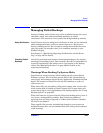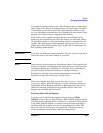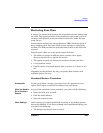
Backup
Managing Failed Backups
Chapter 5264
The following example is a list of files that cannot be opened on an active
Windows NT 4.0 system with the Windows NT software installed on the
C: drive:
<%SystemRoot%>\system32\config\default
<%SystemRoot%>\system32\config\default.LOG
<%SystemRoot%>\system32\config\SAM
<%SystemRoot%>\system32\config\SAM.LOG
<%SystemRoot%>\system32\config\SECURITY
<%SystemRoot%>\system32\config\SECURITY.LOG
<%SystemRoot%>\system32\config\software
<%SystemRoot%>\system32\config\software.LOG
<%SystemRoot%>\system32\config\system
<%SystemRoot%>\system32\config\SYSTEM.ALT
For each user who is logged on, the following files also cannot be opened:
<%SystemRoot%>\Profiles\<user>\NTUSER.DAT
<%SystemRoot%>\Profiles\<user>\ntuser.dat.LOG
IMPORTANT When performing a filesystem backup of a system disk, the previously
listed files are not backed up. Excluding them only solves the problem of
managing the session reports. You should perform a CONFIGURATION
backup to back up the contents of these specific files.
When backing up an inactive system disk (for example in a dual-boot
situation) the previously listed files are not a part of the currently active
CONFIGURATION. These files can be backed up in a filesystem backup, and
should not be excluded.
Preventing Backup Failure
Data Protector provides a set of features that improve backup
robustness, thus lessening the chance that a backup could fail.


















